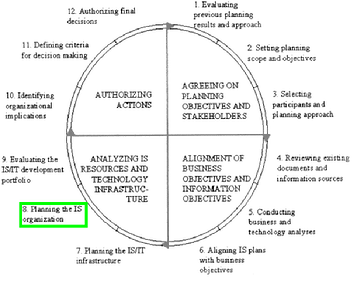-By Sijmen Schoeman, Visualization by Rogier Bennebroek
Introduction
The planning during the third cycle concentrates on assessing the current ICT architecture (short movie) and IS skills, and in preparing for the future [SA2002].
This essay focuses on planning of the ICT organization, and especially on the rules and regulations for the IT function. It covers two important techniques for specifying service levels and financial agreements, respectively service level agreement (SLA) and charge-back methods.

Figure 1: The Four Cycle Method
Service Level Agreements
The goal of an SLA is to bridge the gap between service providers and users. A SLA should contain a number of certain topics[Trienekens et al. 2004]. In order to have a workable result, these topics will be visualized so that the coherence of the different fields (Legal, Quality, Finance and SLA’s) becomes visible. SLA’s can be seen as the umbrella which consists of other factors like legal, quality and financial issues. This can be visualized in the following picture:
Figure 2: visualization of tool 30: rules and regulations of the IT function
Charge-back methods
To avoid abuse of IS services by lack of proper allocation of the corresponding costs a charge-back system is used in many organizations. The standard used to allocate these costs can fall under one of the five categories mentioned in figure 3. Costs that cannot be allocated to specific units are booked as overhead costs. When defining the charge-back method it is also important to keep accountability, controllability, timeliness and congruence with organizational goals in mind. IS services are to be accountable [OZ2001]:
Figure 3: Allocationttool
